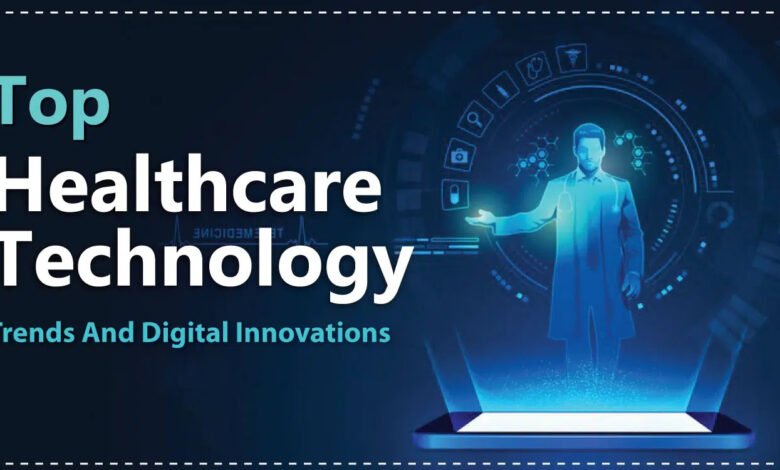Top Tech Trends in Healthcare

Introduction
The healthcare industry is undergoing a seismic shift driven by technological innovation. From diagnosing diseases more accurately to enhancing patient engagement, technology is reshaping every aspect of healthcare. Staying informed about these developments is crucial for patients, providers, and innovators alike. Let’s dive into the most transformative tech trends shaping the future of medicine.
Top Tech Trends in Healthcare
Healthcare innovation is no longer optional; it’s a necessity. By embracing cutting-edge technologies, the industry can deliver better outcomes, reduce costs, and improve patient experiences. Here are the key areas driving this transformation:
Artificial Intelligence (AI) in Healthcare
AI is revolutionizing healthcare with applications that range from diagnosis to personalized care.
- AI in Diagnostics: Machine learning algorithms are achieving diagnostic accuracy levels comparable to seasoned clinicians. They analyze medical images, detect patterns, and identify anomalies that may go unnoticed by human eyes. For example, AI tools are now being used to detect early signs of cancer through imaging, leading to earlier interventions and better outcomes.
- AI-Powered Virtual Assistants: These tools streamline workflows by handling routine tasks like appointment scheduling, medication reminders, and even triaging patients. Chatbots equipped with AI can answer patient queries, reducing the workload on medical staff.
- Predictive Analytics Tools: By analyzing vast datasets, AI can predict disease outbreaks, personalize treatment plans, and identify at-risk populations. Hospitals use predictive models to anticipate patient admissions, ensuring resources are allocated efficiently.
Telemedicine and Remote Care
The COVID-19 pandemic accelerated the adoption of telemedicine, making remote care a mainstay of modern healthcare.
- Virtual Consultations: Patients can consult specialists from the comfort of their homes, reducing travel costs and wait times. This is especially beneficial for individuals with mobility issues or those living in remote areas.
- Remote Patient Monitoring: Devices like smartwatches and home monitoring kits provide real-time health data to healthcare providers. This data allows for proactive management of chronic conditions like hypertension and diabetes.
- Impact on Rural Healthcare Access: Telemedicine bridges the gap for individuals in underserved areas, offering access to quality care. It eliminates geographical barriers and ensures that rural populations receive timely medical attention.
Wearable Health Devices
Wearable tech is transitioning from fitness tracking to comprehensive health monitoring.
- Fitness Trackers Evolving into Health Monitors: Modern devices track heart rates, sleep patterns, and even oxygen levels, offering early warnings for potential health issues. Companies like Fitbit and Apple have introduced features like ECG monitoring, empowering users to take charge of their health.
- Devices for Chronic Disease Management: Wearables help manage conditions like diabetes by continuously monitoring glucose levels and providing actionable insights. These devices not only improve patient outcomes but also reduce the burden on healthcare systems.
Big Data and Analytics
Data is the backbone of modern healthcare innovation.
- Harnessing Healthcare Data: With the increasing digitization of health records, big data enables providers to analyze trends and make data-driven decisions. This leads to more accurate diagnoses and tailored treatments.
- Personalized Treatment Plans: Big data allows for the development of individualized care plans. By analyzing genetic, environmental, and lifestyle factors, healthcare providers can offer precision medicine tailored to each patient.
Blockchain for Data Security
Blockchain technology addresses one of healthcare’s most pressing challenges: data security.
- Enhancing Patient Privacy: Blockchain ensures that patient data is securely encrypted and only accessible to authorized personnel. This reduces the risk of data breaches.
- Reducing Healthcare Fraud: By creating immutable records, blockchain prevents fraudulent activities such as false billing and identity theft.
3D Printing in Healthcare
The versatility of 3D printing is transforming medical treatments.
- Custom Prosthetics and Implants: 3D printing enables the creation of personalized prosthetics and implants tailored to individual patient needs. This reduces the risk of complications and improves patient comfort.
- Printing Human Tissues: Researchers are exploring the use of 3D printing to create human tissues and organs. This technology holds the promise of reducing organ transplant wait times.
Robotics in Surgery
Robotic technology is enhancing precision and efficiency in surgical procedures.
- Robotic-Assisted Surgeries: Robots like the da Vinci Surgical System enable surgeons to perform minimally invasive procedures with greater accuracy. This results in smaller incisions, reduced recovery times, and fewer complications.
- Precision and Faster Recovery Rates: Robotics allow for unparalleled precision, particularly in delicate procedures like neurosurgery and cardiac surgery. Patients benefit from shorter hospital stays and quicker recoveries.
Gene Editing and CRISPR
Gene-editing technologies are opening new frontiers in medicine.
- Revolutionary Disease Treatments: CRISPR technology enables scientists to edit genes, potentially curing genetic disorders like sickle cell anemia and cystic fibrosis.
- Ethical Considerations: While the potential is immense, ethical concerns surrounding gene editing—such as its use in human embryos—must be addressed.
Augmented Reality (AR) and Virtual Reality (VR)
AR and VR are redefining medical training and patient care.
- AR in Medical Training: AR provides immersive training experiences, allowing medical students to practice procedures in a virtual environment before working on real patients.
- VR for Pain Management: VR is being used to distract patients from pain during procedures or as part of therapy for chronic pain conditions.
FAQs
What is the role of AI in healthcare? AI enhances diagnostics, streamlines workflows, and personalizes patient care by analyzing large datasets and automating repetitive tasks.
How does telemedicine improve healthcare access? Telemedicine allows patients to consult doctors remotely, reducing travel time and improving access to care in rural areas.
Are wearable health devices reliable? Yes, modern wearables offer accurate readings and are widely used for monitoring chronic conditions and fitness metrics.
What is blockchain’s potential in healthcare? Blockchain ensures secure, transparent data management, enhancing patient privacy and reducing fraud.
How is 3D printing used in healthcare? 3D printing is used for creating custom prosthetics, implants, and even human tissues for research and treatment.
What challenges come with adopting new healthcare technologies? Challenges include high costs, ethical concerns, and ensuring equitable access across populations.
Conclusion
Technology is undeniably the cornerstone of modern healthcare. By embracing innovations like AI, telemedicine, and wearables, the industry is better equipped to address global health challenges and improve patient outcomes. As we navigate this exciting frontier, balancing innovation with ethical considerations will be key.



